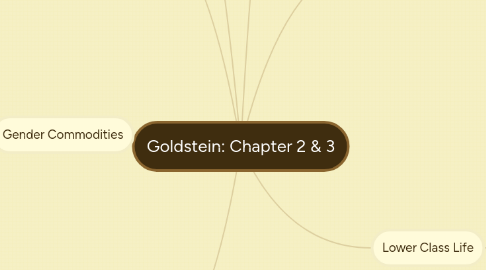
1. Living Wages for Lower Class
1.1. 6 day work week
1.2. The day starts at 5:30am
1.3. 14-15 hour work days
1.4. They have work cards
1.5. Responsibilities of Heavy-Duty Day cleaner
1.5.1. cleaning entire apt
1.5.2. Change bedding
1.5.3. doing laundry
1.5.4. some cooking
1.6. Payment is made on a daily basis
1.7. Gloria's wages were $6 a day (as an example)
1.8. Live ins one command one wage while women who live on their own can command multiple wages and make more money
1.9. Working relationships tend to lean toward a paternalist view
2. Different classes
2.1. Lower class are the domestic workers
2.1.1. Slavery is only a few generations removed and the domestic worker lifestyle still echoes it
2.1.2. Paid domestic workers were stille expected to perform the same responsibilities as previous slaves
2.1.2.1. Sexual Favors for masters and sons
2.1.2.2. Milk nannies for babies
2.1.3. Provide an identity for upper and middle class
2.1.4. Their employers consider them part of their family
2.2. The more workers and more jobs divided between the the higher the class
2.3. Middle class employ the lower class
2.3.1. Feel they are just above the lower class line
2.3.2. Mind set of being dependent of people working for them
2.3.3. Workers do basic jobs for them
2.4. Upper class employ servants without fear of falling below class
2.4.1. Servants range a wider variety of jobs for them
2.4.2. Consider the lower class to be an eye-sore
3. Private and Public Spaces
3.1. Housing is divided into social spaces, intimate space and service spaces
3.2. This helps to split the classes up
4. Gender Commodities
4.1. Men
4.1.1. Financial well-being tends to be a contributing factor
4.1.2. Coroa
4.1.2.1. an older, richer, whiter men
4.1.3. Age doesn't matter to attractiveness
4.2. Women
4.2.1. Beauty and Sex appeal
4.2.2. Sexualized Mulata is internalized
4.2.2.1. Idea of Carnival
4.2.2.2. Seen as a positive image
4.2.2.3. Represent a mixture of Black and White
4.2.3. They are more able to perceive racism then men
4.2.4. Darkness can oversee their poverty or race
5. Lower Class Discrimations
5.1. It is visible and prevents ability to gain proper paying employment
5.2. Feel pressure to work and earn money over schooling
5.3. Afro-Brazilian girls are paid the least amount of any other
5.4. Domestic Work is readily accessible to lower class women
5.4.1. Boa Aparencia
5.4.1.1. a good appearance clause that employers use to discourage dark skinned people from applying
5.4.2. lowest paying employment
6. Lower Class Life
6.1. Families are very dependent on each other and are very big
6.2. Many family members would have to pitch in with the work and cooking around the house
6.3. Money is spread by what is needed for the home and transportation to and from work
6.4. Relationships with employers allows families in times of need to get substantial help
6.5. Lower class boys
6.5.1. Unruly
6.5.2. Join gangs or sell drugs
6.5.2.1. Tend to be more realistic role models
6.5.3. Soccer players
6.6. Lower class girls
6.6.1. Domestic workers
6.6.2. Sex workers
6.6.2.1. Pays more
6.6.2.2. Subjected to predatory patriarchy
6.6.3. Best way to gain class mobility is by seducing an older, richer, whiter men
6.7. Darker skin is seen as ugly and associated with slavery
6.7.1. Different colors signify different races
6.7.1.1. Black
6.7.1.2. White
6.7.1.3. Brown/Mixed
6.7.1.4. Dark
6.7.1.5. Light
6.7.1.6. Closed
6.7.1.7. Freckled
6.7.1.8. More
7. Mixed Race
7.1. Masters would fulfill their fantasies with their mulata or black slaves
7.2. Rape was a big contributor of the mixed race of today
7.3. Politics of sex were taboo to talk about
7.3.1. Jokes, innuendo or silence was a way of expressing these feelings
